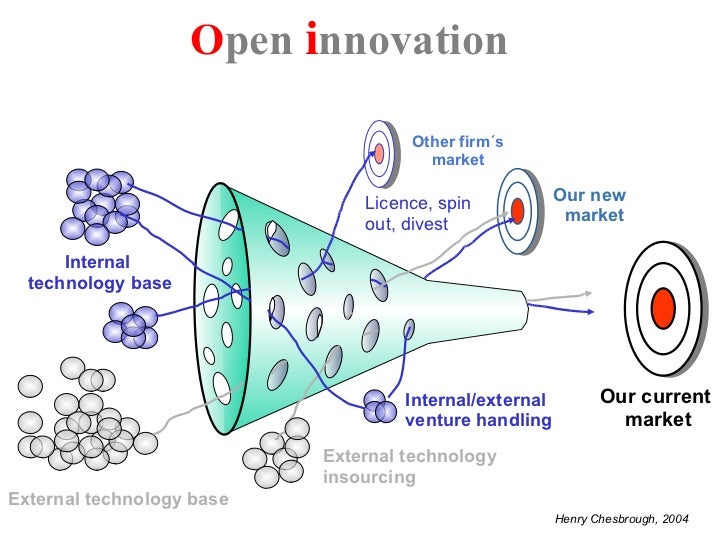Open Innovation
At Ever Evolving, we are proponents of the concept of Open Innovation. As defined by the person who originated the concept, Henry Chesbrough, Open innovation is “the use of purposive inflows and outflows of knowledge to accelerate internal innovation, and expand the markets for external use of innovation, respectively.” Easily stated, it is an organization’s ability to bring ideas in from the “outside” (Source) and capitalize on internally generated ideas outside of the company (Ideation Value). There are always two systems (Source and Ideation Value) to consider when looking at the prospect of Open Innovation for your organization.

Source System
When we speak to partners about the Source System, and any potential open or closed innovation implementation, we have traditionally related it to the concept of public/private cloud. There are certain aspects of your business’ innovations that you are more likely to turn over to someone (for a fee), similar to an * as a Service (*aaS) or public cloud provider, and other ideas you wish to keep private and hold “closer to the chest”.
Some of the organizations we have encountered are beginning to take a blended approach (which we recommend), with some of their innovations being sourced publicly while others private. Having a framework that helps you manage whichever mix you choose is vital to the success of an Open Innovation approach. The following are just a few of the considerations we call out when coaching companies through the analysis of keeping innovations inside of their organization versus sourcing them from outside:
| Considerations | Within the Organization | From Outside the Organization |
| Total Value for Ownership | High | Medium – Very High |
| Implementation Cost | Varies | Varies (but often lower costs) |
| Idea Protection | High | Medium – Low |
| Amount of Ideas | Medium – Low | High |
As an example, let’s take a drug manufacturer, XYZ Pharma, with an idea for a revolutionary nanotechnology treatment delivery system for a new line of cancer treatment medications. The initial idea for the nanotechnology distribution system originated from a research paper from their local university, which built and tested a similar prototype in a non-medical setting. XYZ Pharma’s research has shown that the effectiveness of 3 of their cancer treatment drugs increases by 85% when it enters the human system through the large intestines. They are looking to create a new method of drug delivery that helps to bypass the gut prior to distributing their medication, for maximum effectiveness.
XYZ Pharma plans to partner with a set of companies to build out this new capability, considering they have no expertise in hardware nanotechnology. They also know that their 2 largest competitor have been researching and developing various coatings that would allow a similar effect of bypassing the gut and delivering the medication directly to the large intestines, which to date has shown to have varying levels of effectiveness. They are trying to determine if bringing their 2 largest competitors onto the team would be more beneficial than developing and securing the idea (patent protection) on their own.
There are quite a few things for XYZ Pharma to consider in terms of the Total Value of Ownership. Total cost to develop the new nanotechnology delivery system could cost upwards of 5 billion dollars. In terms of Idea Protection, developing the technology on their own would give them exclusivity in the use of the technology with estimates being 1 – 2 years before competitors could finalize a rival technology. On the other end, if their competitors were brought in early, they could share the cost of development, develop the technology quicker, and grow the market for the delivery system together. A team designed for this type of purpose could also generate far more ideas than XYZ Pharma alone and has a strong potential for all companies to benefit well into the future.
Ideation Value System
How do organizations realize value from the ideas that become products? One way is for the company to either sell the product or they can license aspects of it. Sony was notorious for having superior solutions but often lacked the ability to turn the technology into the market leader. It wasn’t until Sony introduced Blu-ray and licensed it to all their competitors that Sony was finally able maximize the value of another superior idea. Just think if Sony had gone the route of Betamax and tried to become a market leader without sharing some of the Ideation Value. Chances are Blu-ray would have followed in Betamax’s footsteps and we would all have HD-DVD players in our homes today.
Procuring or developing a framework that allows you to manage and maximize the value of your innovations, whether based on the concept of Open Innovation or not, is becoming increasingly important to your business’ success. Innovation has become a new currency of business. We are finding that organizations that consistently innovate outpace their competitors by about 40% average in most industries (and that number is increasing). It is vital that whichever framework you choose to leverage makes it easy to manage the entire innovation process, natively drives efficiency, and helps you realize the most value possible from your efforts. Ever Evolving’s InnoSpecting Framework was developed exclusively for this purpose. To learn more about our InnoSpecting Framework and how it could help to maximize the value of your innovation efforts, contact us at Info@EverEvolving.biz.
Pingback: Conversations with Ever Evolving - What do you think about Open Innovation? - Ever Evolving, Inc.